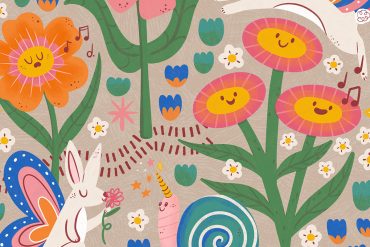This month in the Textile Design Lab we are honored to host guest expert Lital Gold, a textile designer and artist originally from Israel, who moved to Philadelphia in 2011 to work as part of the print-and-color team for Free People. Lital now works from her own studio as a print/CAD designer and you can read more about her in our interview here. Today we hope you enjoy this short excerpt from Lital’s beautiful tutorial on watercolor techniques. Join us today in the Textile Design Lab to access the rest of this in-depth training!
Preparing Your Design
Before you start your watercolor techniques, take your brush and paint some free lines with it. See what kind of results you can get with it and choose the ones will work the best with your trend.
Old and overly used brushes can be great tools for making nice textures. They are also good for “drier” techniques like acrylic. They will give the line a “buzzy” feeling. Try brushes that have different shapes for textures and, as always, feel free to be creative. Try textures you don’t usually try.
After warming up a little bit, take a quick look at your color palette and make sure you stick to it. It’s true that colors can be adjusted easily in Photoshop, but it’s always good to stay close to the source. Sometimes I’d paint small squares at the corner of my paper with my color tones.
You can start with sketching your artwork’s outline with a light pencil (I use B). Make sure not to use the eraser too many times, it ruins the paper.
If you need a good eraser, I usually use FRESH BREAD (yes!) – take a piece of the doughy part and make a ball with your fingers. It’s the best eraser in the world, just make sure not to accidentally eat it afterwards, like I sometimes do without paying attention…
Making an outline is not a must, but it helps with the planning process and with making changes. However, it’s not always necessary, as different artworks can have a freer style to them.
Watercolor Techniques
Working with watercolor and inks are nice and simple as long as your working space is clear and relatively organized and you don’t work too fast.
Here’s a few watercolor techniques to help get you started. Use different amounts of water for every line and learn how to feel when you don’t need anymore water. The most unique thing about watercolor is that the paint spreads, and, if you can control it, the result is amazing. Here’s a simple way of doing it – work with a lot of water and make sure that both your brush AND surface are soaked with clean water. Then, place your brush on one spot and let the paint spread out. You can then work with a little piece of cotton fabric to absorb the water.
Pay attention to the way the colors merge into each other. Sometimes you can stop them from merging too much by putting a little piece of paper towel on the area.
Here’s an example of how to work in layers and create depth with watercolors. The movement and direction of the hand that’s holding the brush is the key here, along with the amount of water. I usually let the paint dry for a minute or two (sometimes even more) between the layers and I highly recommend it. Watercolors need a lot of patience… The darkest mark of paint occurs at the end of a given line (in other words, the visible boundary will happen at the point where the brush lifts from the page)
Don’t forget to switch brushes, as different lines require different thicknesses. Be creative with your process. This working technique has so many different options to offer – you don’t have to use all of them, but be aware of them and know how/when to use them. Most importantly – have fun!
In our FREE 5-Day Design Shake Up we’re sharing the exercises and practices we use to stay creative. Even when life is hectic and busy with work, children, errands and all the rest, the creative habits and techniques we’re sharing keep us inspired and creative. We know they will do the same for you! Ready to dive into this FREE 5-day shake up? Get started here.
















